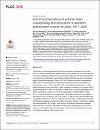First characterisation of antimicrobial susceptibility and resistance of Neisseria gonorrhoeae isolates in Qatar, 2017-2020
| Author | Al-Maslamani, Muna |
| Author | Elmagboul, Emad Bashier Ibrahim |
| Author | Puthiyottil, Aslam |
| Author | Chemaitelly, Hiam |
| Author | Varghese, Manoj Kizhakkepeedikayil |
| Author | Al Romaihi, Hamad Eid |
| Author | Al-Thani, Mohamed H. |
| Author | Al Khal, Abdullatif |
| Author | Unemo, Magnus |
| Author | Abu-Raddad, Laith J. |
| Available date | 2023-07-24T10:35:25Z |
| Publication Date | 2022-03-02 |
| Publication Name | PLoS ONE |
| Identifier | http://dx.doi.org/10.1371/journal.pone.0264737 |
| Citation | Al-Maslamani, M., Elmagboul, E. B. I., Puthiyottil, A., Chemaitelly, H., Varghese, M. K., Al Romaihi, H. E., ... & Abu-Raddad, L. J. (2022). First characterisation of antimicrobial susceptibility and resistance of Neisseria gonorrhoeae isolates in Qatar, 2017–2020. Plos one, 17(3), e0264737. |
| ISSN | 1932-6203 |
| Abstract | Limited data are available regarding antimicrobial resistance in Neisseria gonorrhoeae strains circulating in WHO Eastern Mediterranean Region (EMR). We investigated the antimicrobial susceptibility/resistance of N. gonorrhoeae isolates to five antimicrobials (ceftriaxone, azithromycin, ciprofloxacin, tetracycline, and benzylpenicillin) currently or previously used for gonorrhoea treatment in Qatar, 2017-2020. Minimum inhibitory concentrations (MICs; mg/L) of antimicrobials were determined using Etest on gonococcal isolates collected during January 1, 2017-August 30, 2020 at Hamad Medical Corporation, a national public healthcare provider. During 2017-2020, resistance in isolates from urogenital sites of 433 patients was 64.7% (95% CI: 59.5-69.6%; range: 43.9-78.7%) for ciprofloxacin, 50.7% (95% CI: 45.3-56.1%; range: 41.3-70.4%) for tetracycline, and 30.8% (95% CI: 26.3- 35.6%; range: 26.7-35.8%) for benzylpenicillin. Percentage of isolates non-susceptible to azithromycin was 4.1% (95% CI: 2.0-7.4%; range: 2.7-4.8%) and all (100%) isolates were susceptible to ceftriaxone. Two (1.6%) isolates from 2019 and one (2.2%) isolate from 2020 had high-level resistance to azithromycin (MIC≥256 mg/L). Overall, 1.0% (4/418) of isolates had a ceftriaxone MIC of 0.25 mg/L, which is at the ceftriaxone susceptibility breakpoint (MIC≥0.25 mg/L). Treatment with ceftriaxone 250 mg plus azithromycin 1 g can continuously be recommended for gonorrhoea therapy in Qatar. Continued quality-assured gonococcal AMR surveillance is warranted in EMR. |
| Language | en |
| Publisher | Public Library of Science |
| Subject | antibiotic resistance WHO Eastern Mediterranean Region Anti-Bacterial Agents |
| Type | Article |
| Issue Number | 3 |
| Volume Number | 17 |
Files in this item
This item appears in the following Collection(s)
-
Biomedical Research Center Research [833 items ]


